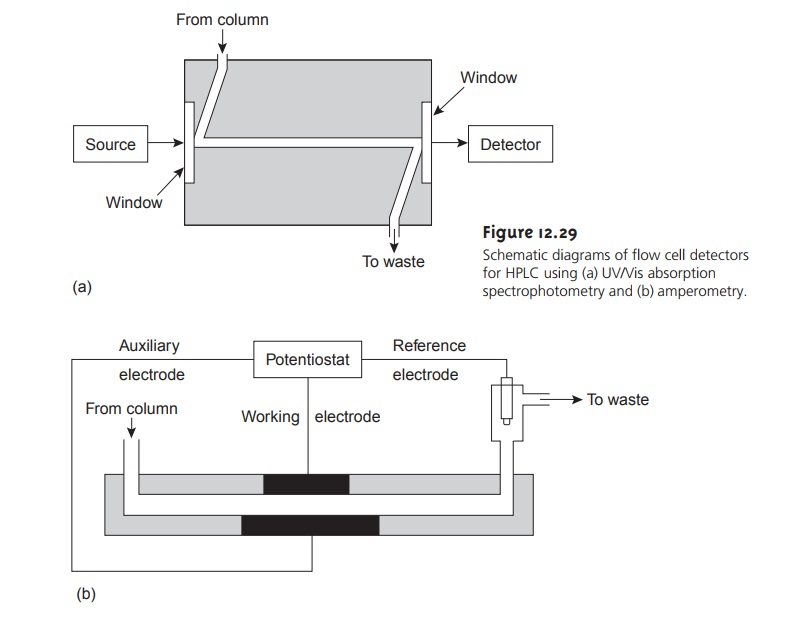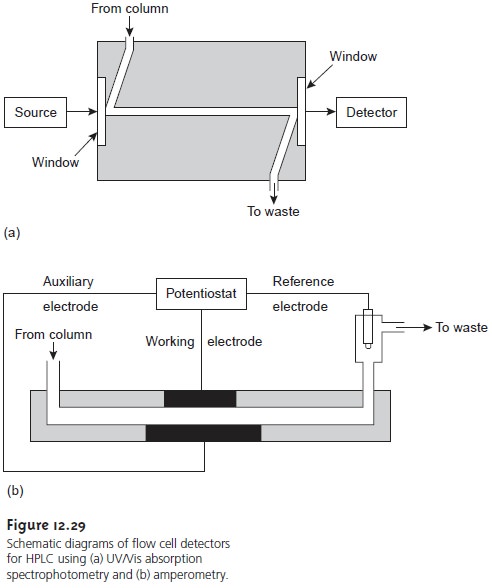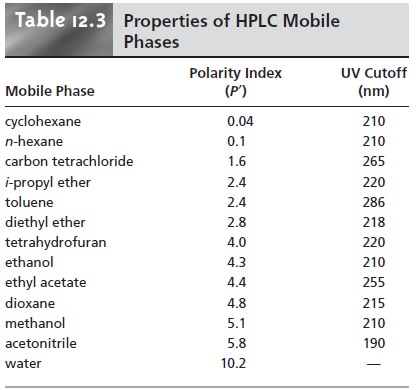Chapter: Modern Analytical Chemistry: Chromatographic and Electrophoretic Methods
High-Performance Liquid Chromatography (HPLC): Detectors for HPLC

Detectors for HPLC
As with gas chromatography, numerous detectors have been
developed for use in monitoring HPLC
separations.14 To date,
the majority of HPLC detectors are not unique to the method,
but are either
stand-alone instruments or modified versions of the same.
Spectroscopic Detectors
The most popular HPLC detectors are based on spectro- scopic measurements, including UV/Vis absorption, and fluorescence. These detec- tors range from simple designs, in which the analytical wavelength is selected using appropriate filters, to essentially a modified spectrophotometer equipped with a flow cell. When using a UV/Vis detector, the resulting chromatogram is a plot of absorbance as a function of elution time. Instruments utilizing a diode array spec- trophotometer record entire spectra, giving a three-dimensional chromatogram showing absorbance as a function of wavelength and elution time. Figure 12.29a shows a typical flow cell for HPLC when using a UV/Vis spectrophotometer as a de- tector. The flow cell has a volume of 1–10 μL and a path length of 0.2–1 cm. One limitation to using absorbance is that the mobile phase must not absorb strongly at the chosen wavelength.


Table 12.3 lists the wavelengths below
which UV/Vis ab- sorbance cannot be used for different mobile phases. Detectors based on ab- sorbance provide
detection limits of as little as 100 pg–1 ng of injected
analyte. Fluorescence detectors provide
additional selectivity since
fewer solutes are
capable of fluorescing. The resulting chromatogram is a plot of fluorescence intensity as a function of time. Detection limits are as little as 1–10 pg of injected
analyte.
Electrochemical Detectors
Another common group
of HPLC detectors are those based on
electrochemical measurements such as amperometry, voltammetry, coulometry, and conductivity. Figure 12.29b, for example, shows an amperometric flow cell. Effluent from the column passes over the working
electrode, which is held
at a potential favorable for oxidizing or reducing the analytes. The potential is held
constant relative to a downstream reference electrode, and the current
flowing be- tween the
working and auxiliary electrodes is measured. Detection limits for
amper- ometric electrochemical detection are 10 pg–1 ng of injected analyte.
Other Detectors
Several other detectors have been used in HPLC.
Measuring a change in the mobile
phase’s refractive index
is analogous to monitoring the mobile
phase’s thermal conductivity in gas chromatography. A refractive index detector is nearly
universal, responding to almost all compounds, but has a poorer detection limit of 100 ng–1 μg of injected analyte.
Furthermore, a refractive index detector is not
useful for a gradient elution
unless the mobile-phase components have identical refractive indexes.
Another useful detector
is a mass spectrometer. The advantages
of using a mass spectrometer in HPLC are the same as for gas chromatography. De- tection limits are quite good, typically 100 pg–1 ng of injected
analyte, with values as
low as 1–10 pg in some situations. In addition, a mass spectrometer provides qualitative, structural information that can help
identify the analytes. The interface
between the HPLC and mass spectrometer is technically more difficult than that in a GC–MS because
of the incompatibility of a liquid mobile
phase with the mass
spectrometer’s high vacuum
requirement. Recent developments in mass spectrome- try, however, have led to a growing interest
in LC–MS.
Related Topics